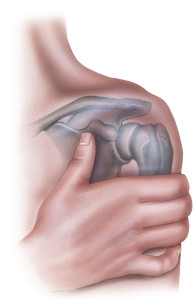Shoulder Injury: Introduction
Have you ever thought to yourself, “My shoulder is killing me,” but you can’t recall injuring it? Or have you ever done something and said, “Uh, oh, I think I just tore something in my shoulder”? Shoulder pain is a common reason for patients to seek orthopedic attention. If you’ve been experiencing occasional discomfort or constant pain, shoulder orthopedic doctors at AOSMI can get to the bottom of your problem.
You may not realize how many components actually make up this complex body part. Your shoulder joint is a relatively shallow ball and socket type of joint. The ball is the upper part of the humerus or arm bone, and the socket is the flat portion of the scapula and known as the glenoid. In addition to bones, your shoulder joint has multiple ligaments, cartilage covering the bones and fibrous cartilage structure known as the labrum, which surrounds the joint.
Shoulder Pain Causes
The most common causes of shoulder pain include:
- Injuries
- Overuse
- Inflammation
Conditions
 The most common conditions involving the shoulder include:
The most common conditions involving the shoulder include:
- Rotator Cuff Tear – The attachment of the rotator cuff muscles tears off the humerus resulting in pain and inability to forcefully lift your arm
- Labral Tear – The cartilage surrounding the shoulder joint becomes torn either through trauma or degeneration. Also known as “SLAP” tear, which means superior labral anterior to posterior tear
- Instability – The shoulder is too loose, resulting from trauma or ligamentous laxity (loose ligaments). This often happens after a shoulder dislocation.
- Bursitis – Inflammation of the subacromial bursa, which allows the rotator cuff to slide underneath the acromion bone on top of the shoulder
- Biceps Tendonitis – Irritation of the biceps tendon as it passes through the shoulder
- Fractures (clavicle, humerus) – The clavicle is one of the most commonly fractured bones, and the proximal humerus bone is often fractured due to falls and injuries
Evaluation
When you visit an orthopedic surgeon shoulder specialist at AOSMI, we will delve into your history and perform a thorough physical examination. In order to properly diagnose your condition, your shoulder will be tested for motion and strength, and placed in positions that might reproduce your symptoms. We will often take X-rays, and if needed, an MRI or CT-scan may be required. For a more accurate assessment, the MRI may be done with an injection of contrast material, known as an “MRI Arthrogram”.
Treatment
Conservative
Shoulder injury treatment depends on the type of problem. For most types of shoulder pain, nonsurgical treatment includes:
- Non-steroidal anti-inflammatory drugs (NSAIDs)
- Manual treatments – Physical therapy, massage and acupuncture
- Use of a brace or a sling
- Injections into the shoulder joint for disorders such as arthritis, bursitis and tendinitis. The injections can be placed inside your shoulder joint (intraarticular injection), into your bursa (subacromial injection) or into tendons. Steroids, orthobiologics and hyaluronic acid can be used for shoulder injections
Surgical
If you have not responded to more conservative treatments, you may require the help of an orthopedic surgeon shoulder specialist:
- Open reduction and internal fixation or intramedullary fixation – Useful for the repair of fractures
- Arthroscopic rotator cuff repair – If you’ve torn your rotator cuff, this minimally invasive surgery provides excellent results with rapid recovery
- Arthroscopic labral repair – Repairs labrum damage or shoulder instability
- Bicipital tenotomy – Severing and reattaching of inflamed biceps tendon
- Arthroscopic subacromial resection and bursectomy – Minimally invasive surgery alleviates symptoms of significant shoulder bursitis
- Mumford procedure – Treats the acromioclavicular joint, which attaches your clavicle to your shoulder bone (scapula)
- Total shoulder joint replacement – An option for those experiencing significant arthritis
- Partial shoulder replacement or hemiarthroplasty – Recommended for severe fractures of the humerus bone
- Reverse total shoulder arthroplasty – A newer procedure to treat advanced disease of the shoulder
If you’ve recently had a shoulder injury or have unexplained discomfort, contact shoulder orthopedic doctors AOSMI. There is no reason to go on living with pain when the right treatment is just waiting for you.








